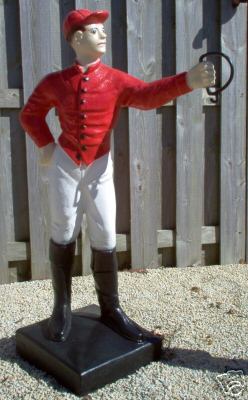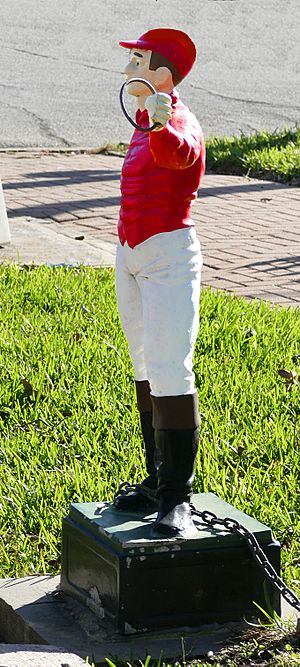Lawn jockey facts for kids
A lawn jockey is a small statue of a person dressed in jockey clothes. These statues are usually placed in front yards. Long ago, some were used as hitching posts for horses. They were like garden gnomes or statues of footmen holding lanterns.
In the past, many lawn jockeys showed black people with exaggerated features. Because of this, they became symbols of racism and unfair treatment of black people in the United States. This was especially true during the time of slavery and Jim Crow laws. Today, many lawn jockeys show white boys to avoid these hurtful meanings.
These statues were once very popular in parts of the United States and Canada. They were usually half the size of a real person or smaller. They showed a person in jockey clothes holding one hand up, as if holding horse reins. Sometimes, this hand had a metal ring for tying a horse. Other times, it held a lantern that might or might not light up.
At first, lawn jockeys were a friendly way to welcome guests. They also offered a useful place to tie a horse. Later, they became mostly decorative. People who liked the style of the Old South or horse riding often chose them.
Historically, the black jockey statues often showed racist images of African Americans. There were two main styles: a shorter one called "Jocko" and a taller one called "cavalier spirit". The "Jocko" style was usually stockier and hunched over. The "cavalier spirit" style was more slender. These statues were often made of concrete, iron, or aluminum. The original racist images are no longer used today.
Contents
Types of Lawn Jockeys
The "Jocko" Style
The older "Jocko" design usually has the right arm raised. It was made to look like a racist caricature of a young black boy. This often included exaggerated features. For example, they had big eyes with white paint, large red lips, a flat nose, and curly hair. These statues were often painted in bright racing colors for the uniform. The skin was usually glossy black.
By the 20th century, these statues were seen as racist. Many that still exist have been repainted. Their skin is now often pink, but the original exaggerated features can still be seen.
The "Cavalier Spirit" Style
The "cavalier spirit" design usually has the left arm raised. It looks like a white young man. This style does not have the exaggerated, racist features of the "Jocko" type. These statues were also painted in strong colors. Their skin could be glossy black or pastel pink. They often had red lips, white pants, black boots, and a bright red or dark green vest and cap. Sometimes, the vest and cap were painted in the bright colors of a jockey's racing silks.
You can see several "cavalier spirit" jockey statues at the entrance of the 21 Club in Manhattan. They are also at the entrance of the Santa Anita Park clubhouse in Los Angeles.
Historical Stories and Legends
Underground Railroad Connection?
Some people claim that lawn jockeys were used during the Underground Railroad. This was a secret network that helped enslaved people escape to freedom. Charles L. Blockson, an expert on African-American history, said that green ribbons tied to the statues meant safety. Red ribbons meant to keep going. Patterns on the clothing were also said to carry messages for escaping slaves.
However, historians have not found proof for these claims. The Jim Crow Museum of Racist Memorabilia also states there is little evidence that lawn jockeys were used this way.
Revolutionary War Legend
There is a popular story about the origin of the lawn jockey. It says the statue honors a hero from African-American history. According to the River Road African American Museum, the figure started as a tribute to a young man's dedication.
The story tells of a young African-American boy named Jocko Graves. He served with General George Washington during the American Revolutionary War. When Washington crossed the Delaware River for a surprise attack, Jocko was too young to go. He was left on the Pennsylvania side to care for the horses. He was told to keep a light on the bank for their return. The legend says Jocko stayed at his post and froze to death during the night, still holding the lantern.
General Washington was supposedly so moved by Jocko's loyalty that he had a statue made. It showed Jocko holding the lantern and was placed at his Mount Vernon estate. He called it "The Faithful Groomsman."
This story is often mentioned by Kenneth W. Goings in his book "Mammy and Uncle Mose." However, he considers it a legend, not a fact. There are also children's books and typescripts about Jocko Graves.
Despite the popular legend, historical records do not support it. An archivist from Mount Vernon stated in 1987 that there is no record of a Jocko Graves. There is also no account of someone freezing to death while holding Washington's horses.
Lawn Jockeys in Pop Culture
Lawn jockeys sometimes appear in movies and TV shows. They can be just a decoration or part of a conversation. Earlier versions of lawn jockeys often bring up ideas about racism. More modern ones usually do not.
Sometimes, a lawn jockey is used to show a point about race. For example, in an episode of The Golden Girls, Sophia jokes about Blanche's Southern background. She suggests Blanche "tar and feather the neighbour's lawn jockey" to make her father feel at home. In All in the Family, Archie Bunker gets a black lawn jockey as a gift. It is meant to annoy him because of his known racism. But Archie actually finds the racist gift inappropriate.
Lawn jockeys are often linked to wealthy white American families in popular culture. This can be for humor, social commentary, or just for their look. Here are some examples:
- In Raymond Chandler's 1942 novel The High Window, a lawn jockey is at the home of a rich family. The detective, Philip Marlowe, jokingly talks to the statue. He calls it the most stable member of the family.
- A lawn jockey comes to life in Stephen King's 2008 novel Duma Key.
- Lawn jockeys appear in several episodes of Dear White People.
- In The Golden Girls, lawn jockeys are often mentioned when talking about Blanche Devereaux's Southern family. This often hints that Blanche's family, who lived on a plantation and owned slaves, might have racist views.
Images for kids
-
Example bearing a lantern in Guyton, Georgia
-
Example bearing a lantern in Perry, Georgia







